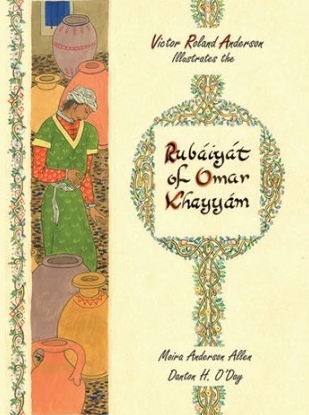Khayyam, Omar: iv. English Translations of the Rubaiyat. Austin O’Malley
In: Encylcopædia Iranica, edited by Ehsan Yarshater and Elton Daniel, 16:464-70. Leiden: Brill.
Over the past one hundred and fifty years, the quatrains of Khayyam have been translated into English more often than the verse of any other Persian poet. The bibliographies of Ambrose Potter and Jos Coumans together list nearly one hundred translators and editors for the Rubaiyat in English. Out of this mass of material, however, only a few dozen translations enjoyed considerable circulation or exerted lasting influence on the tradition of the Rubaiyat in English. These can be heuristically divided into two categories: those based directly on the Persian, and those based on previous translations in English or other languages
Rubaiyat. Omar Jayam. Edward FitzGerald. Ilustraciones de Willy Pogány. Traducción de Victoria León. Prólogo de Luis Alberto de Cuenca. Madrid, Reino de Cordelia, 2019. – 124 p.; illustrations; 19 x 15,5 cm. – (Los versos de Cordelia). – ISBN: 978-84-16968-94-7.
75 quatrains
– Índice, p. 9
– Omar Jayam, poeta de todos, p. 13
– [Rubaiyat], p. 19 .
Omar Khayyâm. Vin, amour, volupté. [Trad. Charles Grolleau]. Calligraphies de Lassaâd Metoui ; préface de Leili Anvar. Paris, Trédaniel, 2019. – 261 p.; 31 x 31 cm. – ISBN: 9782813221452.
126 quatrains.
Contents
– En appendice, “Carnets de voyage conc¸us au British Museum”, et “Les courbes de l’ivresse”.
– Préface, p. 8
– Introduction, p. 14
– Les quatrains d’Omar Khayyâm — Carnets de voyage conçus au British Museum, p. 233
– Galerie imaginaire, p. 241
– Annexes
Victor Roland Anderson Illustrates the Rubaiyat of Omar Khayyam. [Translated by Edward FitzGerald]. Edited by Danton O’Day and Moira Anderson Allen. [S.l.], Blurb, 2019. – 36 p.; 15 full page illustrations in colour; 25,5 x 20 cm. – ISBN: 978-0-46-425914-5.
75 quatrains
Khayyám’s Rubáiyát. A new version in English verse by Frank Coffman. Transformed from the prose translation by Justin Huntly McCarthy. [S.l.], Bold Venture Press, 2019. – xxvii, 86 p.; With portraits in b&w of E. Heron-Allen, J. Huntly McCarthy and R. le Gallienne; 23 x 15 cm. – ISBN: 9781097209286.
466 quatrains.
Introduction, p. i
[Rubáiyát], p. [1]
Glossary, p. 85.
Omar Chajjam. Rubai. Cecilia Banu. Moskou; St. Peterburg, Letnii Sad; Universitetskaia Kniga, 2019. – 145 p.; 10 x 9 cm. – ISBN: 978-5-98856-398-3.
104, 34 quatrains. – With 34 pages text in Persian.
Contents
– Omar Chajjam, [p. 3]
– O taynakh bytiyak, p. 7
– O neprochnosti vsego zemnogo, p. 44
– Ob ushedshikh godakh i druzyakh, p. 74
– Vino, vesel’ye, vol’nodymstvo, p. 82
– Vino, lyubov’, gryst’, 101
– Vino i umerennost’ p. 120
– Vino i litsemeri, p. 125|
– K illyustratsiyam, p. 145
Omar Khayyám on theodicy. Irreconcilability of the transcendental and the imminent. Mehdi Aminrazavi
In: Journal of Islamic Philosophy, 11 (2019), p. 33-44.
Abstract
The philosophical and theological thoughts of Omar Khayyām, the Persian mathematician, astronomer, and the likely author of the Rubāʿiyyāt (Quatrains), has remained a neglected area of scholarship. Much of the scholarship on Khayyām in the last few centuries has primarily been focused on his Quatrains, and to a lesser extent, on his views on mathematics and geometry. Despite Khayyām’s significance, his six philosophical treatises were not even edited nor published until recently, which is perhaps why they have remained relatively obscure. In this article, Khayyām’s dual views on theodicy are presented notwithstanding that he is the only figure we know of in the annals of Islamic intellectual history who adopted two opposite positions—simultaneously— with regard to the problem of evil. This article postulates that Khayyām’s dual positions on theodicy can only be understood if they are placed in their proper contexts; philosophically, theodicy is explainable, while on a more experiential level it is not. Conclusions may vary, depending on whether we are looking at the presence of evil from a transcendental or an imminent perspective.




